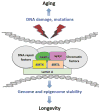DNA double strand break repair, aging and the chromatin connection
- PMID: 26923716
- PMCID: PMC4887314
- DOI: 10.1016/j.mrfmmm.2016.02.004
DNA double strand break repair, aging and the chromatin connection
Abstract
Are DNA damage and mutations possible causes or consequences of aging? This question has been hotly debated by biogerontologists for decades. The importance of DNA damage as a possible driver of the aging process went from being widely recognized to then forgotten, and is now slowly making a comeback. DNA double strand breaks (DSBs) are particularly relevant to aging because of their toxicity, increased frequency with age and the association of defects in their repair with premature aging. Recent studies expand the potential impact of DNA damage and mutations on aging by linking DNA DSB repair and age-related chromatin changes. There is overwhelming evidence that increased DNA damage and mutations accelerate aging. However, an ultimate proof of causality would be to show that enhanced genome and epigenome stability delays aging. This is not an easy task, as improving such complex biological processes is infinitely more difficult than disabling it. We will discuss the possibility that animal models with enhanced DNA repair and epigenome maintenance will be generated in the near future.
Keywords: Aging; DNA double strand break repair; Epigenome; Genomic instability; Heterochromatin; Longevity.
Copyright © 2016 Elsevier B.V. All rights reserved.
Figures

References
-
- Ness KK, Krull KR, Jones KE, Mulrooney DA, Armstrong GT, Green DM, Chemaitilly W, Smith WA, Wilson CL, Sklar CA, Shelton K, Srivastava DK, Ali S, Robison LL, Hudson MM. Physiologic frailty as a sign of accelerated aging among adult survivors of childhood cancer: a report from the St Jude Lifetime cohort study. J Clin Oncol. 2013;31:4496–4503. - PMC - PubMed
-
- Dolle MET, Giese H, Hopkins CL, Martus HJ, Hausdorf JM, Vijg J. Rapid accumulation of genome rearrangements in liver but not in brain of old mice. Nat Genet. 1997;17:431–434. - PubMed
Publication types
MeSH terms
Substances
Grants and funding
LinkOut - more resources
Full Text Sources
Other Literature Sources
Medical

